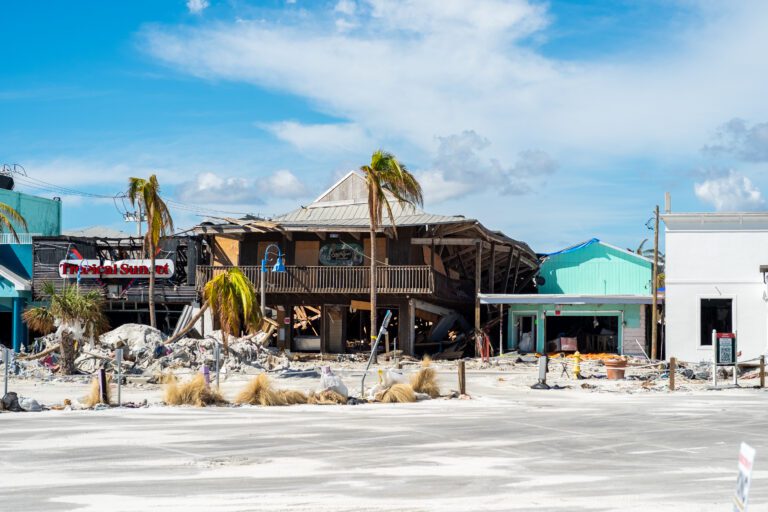
If you’ve been financially impacted by the storm, know where to turn to find help.
With power restored to a vast majority of residents, businesses open and workers back on their jobs, it seems like Plant City is getting back to business as usual. For some who’ve sustained hurricane damage to their homes, the path to recovery can be fraught with uncertainty about where to turn for assistance. Beyond filing a homeowner’s insurance claim, here are government resources that are being offered to help storm-weary residents get back on their feet after the disaster.
FEMA
If you qualify for FEMA assistance, you may first receive money for essential items like water, food, infant formula, medical supplies and more. Your application will also be assessed to determine if you qualify for other forms of assistance. Even if you’re unsure of what FEMA will cover, take as many photos as possible of the damages to your house and property, and take time to apply for assistance.
Here are ten items you might qualify for after a disaster:
1. Home repair or replacement.
If your home was damaged by the disaster, you may receive money to help you repair or replace your home. This can even include money to help you address mold in your home caused by the disaster.
2. Accessibility needs.
If you have a disability, you could receive money to help with specific repairs to make sure your home is accessible.
3. Rental assistance.
If you are displaced from your home because of the disaster, you could receive money to use to rent housing.
4. Privately-owned roads, bridges or docks.
If the only access to your home has been damaged by the disaster, you could receive money for repairs.
5. Displacement.
If you cannot return to your home because of a disaster, you could receive money to help with immediate housing needs. The money can be used to stay in a hotel, with family and friends or for other options while you look for temporary housing.
6. Personal Property.
You could receive money to help you repair or replace appliances, room furnishings, a personal or family computer damaged by the disaster, books, uniforms, tools and additional computers and other items required for school or work.
7. Childcare.
You could receive money to help pay for increased or new childcare expenses caused by the disaster.
8. Transportation.
You could receive money to help you repair or replace a vehicle damaged by the disaster when you don’t have another vehicle you can use.
9. Moving and storage expenses.
You could receive money to help you move and store personal property from your home to prevent additional damage, usually while you are making repairs to your home or moving to a new place due to the disaster.
10. Medical/Dental Help.
If the disaster caused an injury or illness, you could receive money to help pay for medical expenses.
If you need help, apply for FEMA assistance through DisasterAssistance.gov. You can also visit a FEMA Disaster Recovery Center to meet face-to-face with FEMA representatives, apply for FEMA assistance, receive referrals to local assistance in their area, apply with the U.S. Small Business Administration (SBA) for low-interest disaster loans (which has currently run out of funds but is still accepting applications in the hopes that Congress will extend additional funding) and much more.
Find a Disaster Recovery Center on the FEMA website or text “DRC” and a Zip Code to 43362. You may also apply for assistance and find locations for Disaster Recovery Centers on the FEMA mobile app, or get help by calling 1-800-621-3362.
Multi-Agency Resource Centers (MARCs) Opened
Hillsborough County and the Florida Department of Emergency Management (FDEM) is expanding the Multi-Agency Resource Centers (MARC) to assist individuals, families, businesses and non-profits impacted by Hurricanes Milton, Helene and Debby. The center, located at the Florida Strawberry Festival TECO Expo Hall at 2301 W. Oak Ave., is expected to be staffed with personnel from federal, state, regional partners and non-profit agencies to ensure residents have access to all available resources following the storm events. It will be open seven days a week from 9 a.m. to 5 p.m. until further notice.
Additionally, Hillsborough County has created a webpage with local, state and national resources available to residents as they recover from the storms. Residents can find these resources at www.HCFL.gov/StormRecovery.
Possible Property Tax Relief
Hillsborough County Property Appraiser Bob Henriquez announced he has created a coalition of local government officials with the aim of providing tax relief for area homes and business owners who suffered property damage.
“Our community has been hit hard by these storms and we are committed to doing everything we can to support our residents during this difficult time,” Henriquez said. “This coalition will work together to explore various options for property tax relief, ensuring that home and business owners can focus on rebuilding their lives and repairing their property.”
Property owners can submit damage reports by visiting the HCPA’s Damage Assessment Form (https://dmz.hcpafl.org/storm/), emailing the office at StormDamage@hcpafl.org, or calling the HCPA’s Property Damage Hotline at 813-272-6332.
Fannie Mae Assistance
Homeowners and renters impacted by natural disasters have available mortgage assistance and disaster relief options.
“Once recovery efforts begin, we encourage homeowners experiencing hardship because of the storm to contact their mortgage servicer about payment relief options as soon as possible,” said Cyndi Danko, Senior Vice President and Chief Credit Officer, Single-Family, Fannie Mae. “Homeowners and renters alike can learn more about disaster relief resources, including personalized support, by contacting Fannie Mae’s free disaster recovery counseling services.”
Homeowners and renters can call 855-HERE2HELP (855-437-3243) to access Fannie Mae’s disaster recovery counseling or visit www.yourhome.fanniemae.com for more information.
